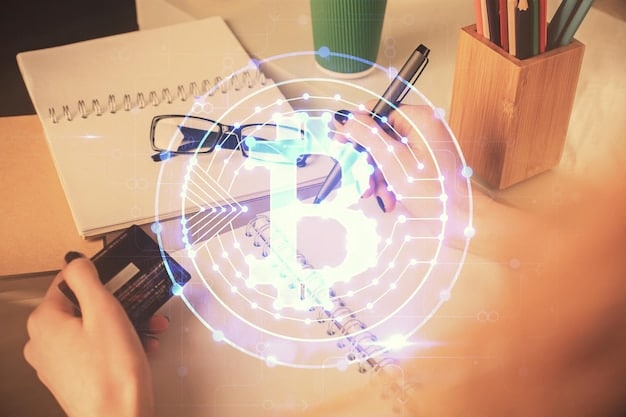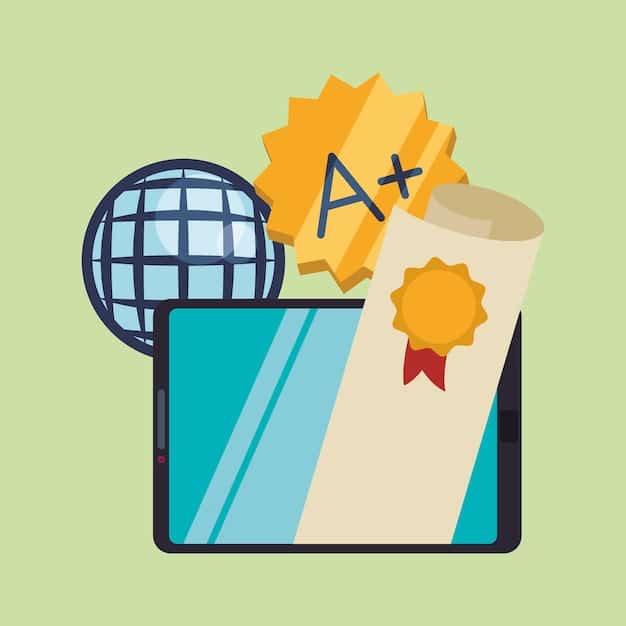Blockchain in Education: Securing Records & Credentials in 2025

Blockchain technology in education provides a secure and transparent method for managing student records and credentials, ensuring data integrity and enhancing trust in educational systems by 2025.
The increasing demand for secure and transparent systems in education makes exploring blockchain technology in education: securing student records and credentials in 2025, a crucial topic for educators and administrators alike.
Understanding Blockchain Technology for Education
Blockchain technology is revolutionizing various sectors, and education is no exception. Understanding its fundamental principles is key to grasping its potential impact.
At its core, a blockchain is a decentralized, immutable ledger that records transactions across many computers. This means that no single entity controls the data, and once a transaction is recorded, it cannot be altered or deleted.
Key Features of Blockchain
Several features make blockchain technology particularly appealing for educational institutions.
- Decentralization: Data is distributed across multiple nodes, eliminating a single point of failure.
- Transparency: All participants in the network can view the recorded transactions.
- Security: Cryptographic algorithms secure the data, making it extremely difficult to tamper with.
- Immutability: Once a transaction is recorded, it cannot be altered or deleted.
These features collectively enhance trust and security, which are critical in managing sensitive student data.
Blockchain’s inherent security measures provide an unparalleled level of protection against fraud and unauthorized access.
The Current State of Student Record Management
Traditional methods of managing student records are often fragmented, inefficient, and vulnerable to security breaches. This creates challenges for both institutions and students.
Currently, student records are typically stored in centralized databases controlled by individual educational institutions. This system presents several issues.
Challenges with Traditional Systems
Traditional systems are plagued by various problems that hinder efficiency and security.
- Data Silos: Records are often scattered across different departments and institutions, making it difficult to obtain a comprehensive view of a student’s academic history.
- Security Risks: Centralized databases are vulnerable to cyberattacks, which can result in the loss or theft of sensitive student data.
- Inefficiency: Transferring records between institutions can be a slow and cumbersome process, often involving manual verification and paperwork.
These shortcomings highlight the need for a more streamlined and secure approach to managing student records.
Many students find the current process of obtaining and sharing their academic records to be unnecessarily complex and time-consuming.
How Blockchain Secures Student Records
Blockchain technology offers a solution to many of the challenges associated with traditional student record management systems. By leveraging its decentralized and secure nature, blockchain can enhance data integrity, improve efficiency, and foster greater trust.
With blockchain technology in education, each student record can be represented as a block in the chain, securely linked to previous records. This ensures that the data is tamper-proof and verifiable.

Benefits of Using Blockchain for Student Records
Several benefits make blockchain an attractive option for educational institutions looking to modernize their record management systems.
- Enhanced Security: Blockchain’s cryptographic algorithms ensure that student data is protected from unauthorized access and tampering.
- Improved Data Integrity: The immutable nature of blockchain ensures that records cannot be altered once they are recorded, providing a reliable source of truth.
- Streamlined Verification: Employers and other institutions can quickly and easily verify the authenticity of student credentials through the blockchain.
By implementing blockchain-based systems, educational institutions can provide students with greater control over their academic records and foster greater trust in the validity of credentials.
The ability to instantly verify credentials can significantly reduce administrative overhead and improve the efficiency of the hiring process.
Implementing Blockchain in Education by 2025
The widespread adoption of blockchain technology in education by 2025 will require a concerted effort from educators, administrators, and technology providers. This will involve addressing various challenges and implementing effective strategies.
To successfully implement blockchain, institutions must overcome technological, regulatory, and cultural hurdles. A phased approach, starting with pilot projects, can help to mitigate risks and build confidence.
Steps for Successful Implementation
A well-planned strategy is essential for the successful implementation of blockchain in education.
- Pilot Projects: Start with small-scale pilot projects to test the technology and identify potential issues.
- Stakeholder Engagement: Involve educators, administrators, and students in the implementation process to ensure that their needs are met.
- Regulatory Compliance: Ensure that the use of blockchain technology complies with relevant data privacy regulations.
Collaboration among institutions, technology providers, and regulatory bodies will be crucial for establishing industry standards and best practices.
Educating stakeholders about the benefits of blockchain can help to overcome resistance to change and promote wider adoption.
Use Cases of Blockchain in Education
Beyond securing student records, blockchain technology has numerous other potential applications in the education sector. These use cases range from managing intellectual property to facilitating peer-to-peer learning.
One promising application is the use of blockchain to manage and protect intellectual property rights. Researchers and educators can use blockchain to track and verify the ownership of their work.
Other Potential Applications
Blockchain technology can also be used to address a variety of other challenges in education.
- Credential Verification: Blockchain can be used to issue and verify digital credentials, making it easier for students to showcase their skills and qualifications.
- Intellectual Property Management: Researchers and educators can use blockchain to protect their intellectual property rights.
- Peer-to-Peer Learning: Blockchain can facilitate the creation of decentralized learning platforms where students can earn rewards for sharing their knowledge and expertise.
These diverse use cases highlight the transformative potential of blockchain in education.
The development of blockchain-based micro-credentialing systems can provide students with more flexible and personalized learning opportunities.

The Future of Blockchain in Education
Looking ahead, blockchain technology in education is poised to play an increasingly important role in shaping the future of learning. Its ability to enhance security, improve efficiency, and foster greater trust makes it an invaluable tool for educational institutions.
In the years to come, we can expect to see more widespread adoption of blockchain-based systems for managing student records, issuing digital credentials, and facilitating peer-to-peer learning. This will require ongoing innovation and collaboration among stakeholders.
Emerging Trends and Opportunities
Several emerging trends and opportunities are likely to shape the future of blockchain in education.
- Integration with AI: Combining blockchain with artificial intelligence can enable more personalized and adaptive learning experiences.
- Decentralized Learning Platforms: Blockchain can facilitate the creation of decentralized learning platforms that empower students and educators.
- Cross-Institutional Collaboration: Blockchain can enable seamless data sharing and collaboration among different educational institutions.
These developments promise to unlock new possibilities for innovation and improvement in the education sector.
The integration of blockchain with other emerging technologies is likely to create even more opportunities for innovation in education.
By embracing blockchain technology, educational institutions can position themselves at the forefront of innovation and provide students with a more secure, efficient, and transparent learning experience.
In conclusion, integrating blockchain into education requires overcoming challenges, but the potential benefits for security, efficiency, and trust are significant. As we approach 2025, strategic planning and collaborative efforts are essential to harnessing the full power of blockchain for the advancement of education.
| Key Point | Brief Description |
|---|---|
| 🛡️ Enhanced Security | Blockchain’s cryptography protects student data from unauthorized access. |
| ✅ Data Integrity | Immutable records ensure that academic credentials are tamper-proof. |
| 🚀 Streamlined Verification | Employers can quickly verify credentials through blockchain, reducing delays. |
| 🌐 Decentralization | Data is distributed across multiple nodes, eliminating a single point of failure. |
Frequently Asked Questions
▼
Blockchain is a decentralized, immutable ledger that records transactions across many computers. This setup enhances security and transparency.
▼
Blockchain uses cryptographic algorithms to secure data, protecting it from unauthorized access and tampering. This ensures data integrity.
▼
Benefits include enhanced security, improved data integrity, and streamlined verification of credentials. These advantages improve efficiency.
▼
Institutions can start with pilot projects, engage stakeholders, and ensure compliance with data privacy regulations. A phased approach works well.
▼
Blockchain can manage intellectual property, facilitate peer-to-peer learning, and issue digital credentials, expanding its utility in education.
Conclusion
In conclusion, blockchain technology in education holds immense potential for transforming the sector by enhancing security, transparency, and efficiency in managing student records and credentials by 2025. Embracing this technology can lead to a more trustworthy and streamlined educational ecosystem.





